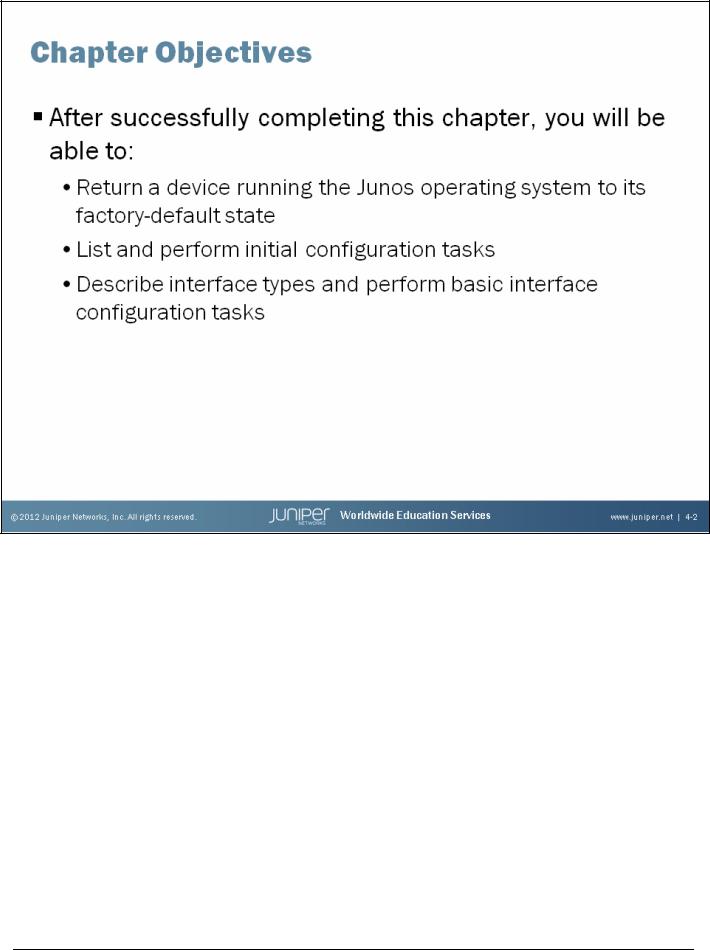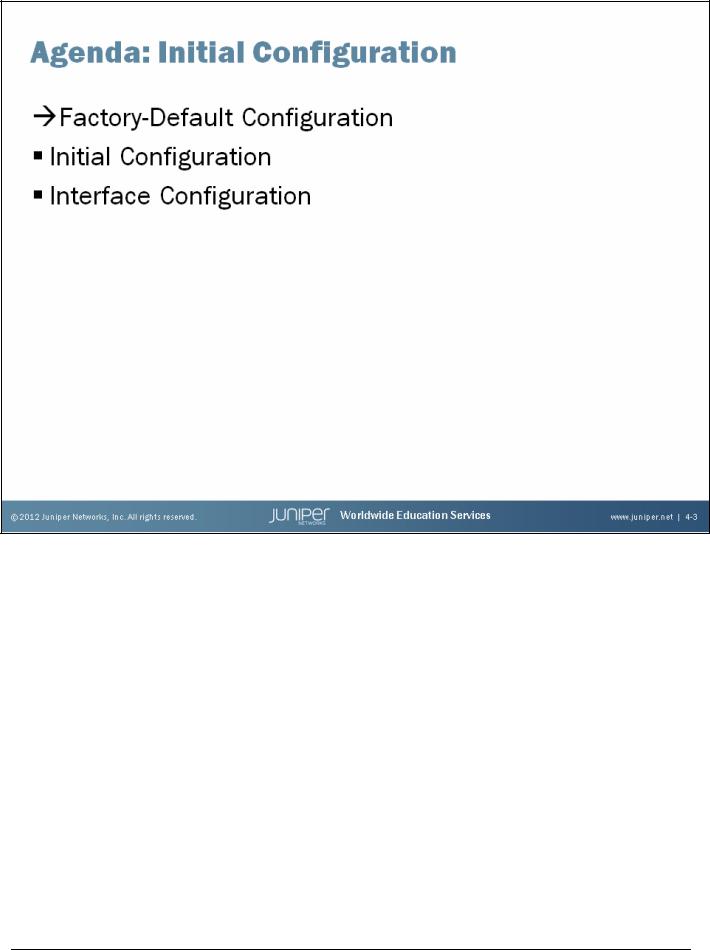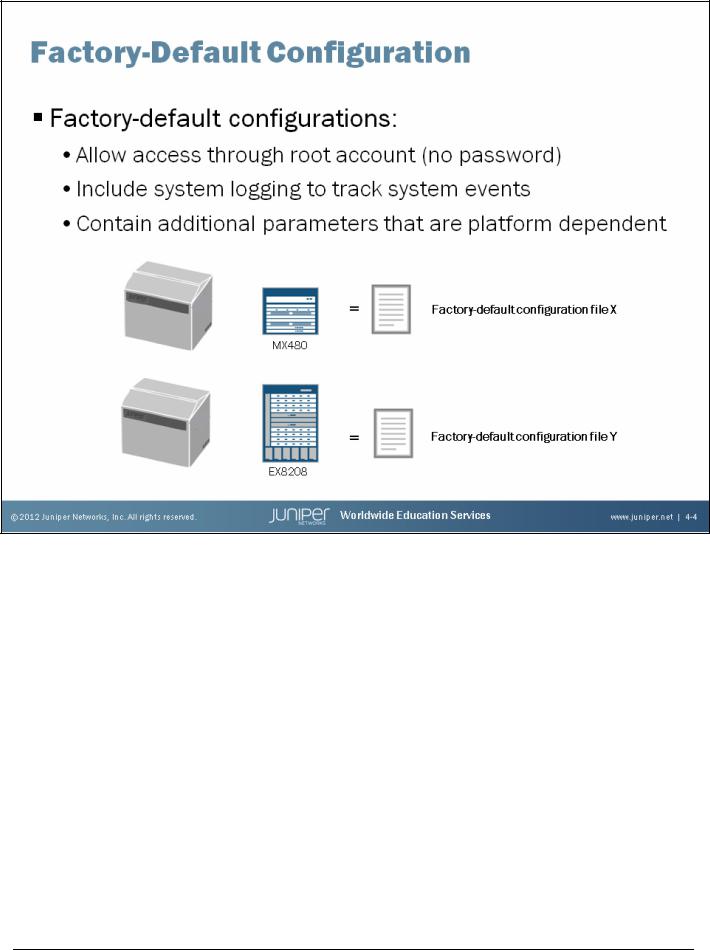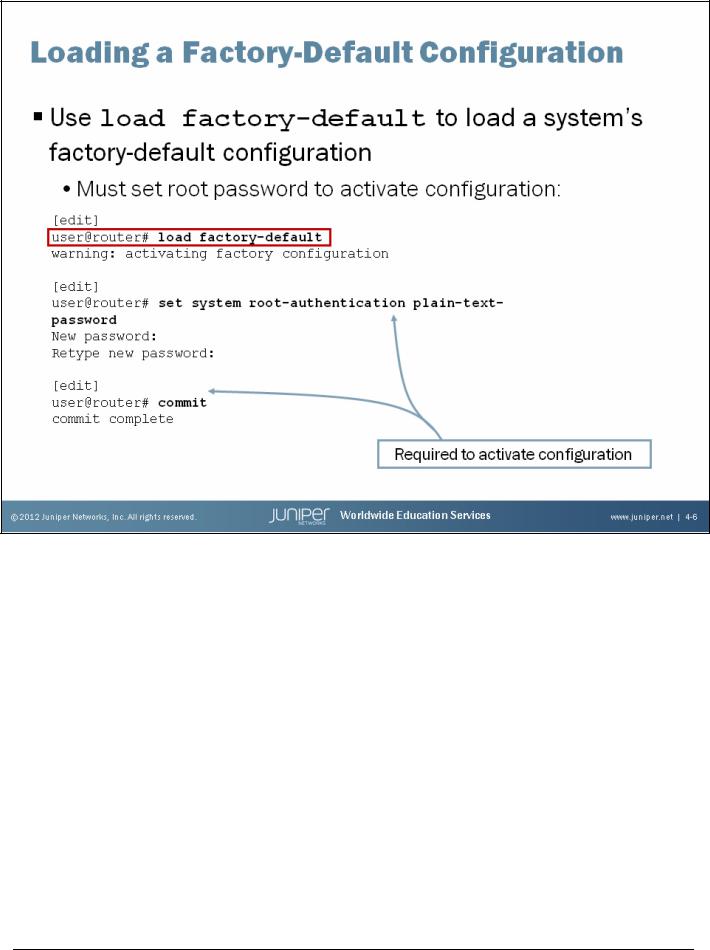
- •Contents
- •Course Overview
- •Course Agenda
- •Document Conventions
- •Additional Information
- •Chapter 1: Course Introduction
- •Chapter 2: Junos Operating System Fundamentals
- •The Junos OS
- •Traffic Processing
- •Overview of Junos Devices
- •Chapter 3: User Interface Options
- •User Interface Options
- •The Junos CLI: CLI Basics
- •The Junos CLI: Operational Mode
- •The Junos CLI: Configuration Mode
- •Lab 1: The Junos CLI
- •Chapter 4: Initial Configuration
- •Factory-Default Configuration
- •Initial Configuration
- •Interface Configuration
- •Lab 2: Initial System Configuration
- •Chapter 5: Secondary System Configuration
- •User Configuration and Authentication
- •System Logging and Tracing
- •Network Time Protocol
- •Archiving Configurations
- •SNMP
- •Lab 3: Secondary System Configuration
- •Monitoring Platform and Interface Operation
- •Network Utilities
- •Maintaining the Junos OS
- •Password Recovery
- •Lab 4: Operational Monitoring and Maintenance
- •Appendix A: Interface Configuration Examples
- •Review of the Interface Configuration Hierarchy
- •Interface Configuration Examples
- •Using Configuration Groups
- •Appendix B: The J-Web Interface
- •Configuration
- •Lab 5 (Optional): The J-Web Interface
- •Appendix C: Acronym List
- •Appendix D: Answer Key
- •Chapter 1: Course Introduction
- •Chapter 2: Junos Operating System Fundamentals
- •Chapter 3: User Interface Options
- •Chapter 4: Initial Configuration
- •Chapter 5: Secondary System Configuration
- •Chapter 6: Operational Monitoring and Maintenance

Introduction to the Junos Operating System
Chapter 4: Initial Configuration

Introduction to the Junos Operating System
This Chapter Discusses:
•The factory-default configuration for platforms running the Junos operating system;
•Initial configuration tasks performed on devices running the Junos OS; and
•Interface types and interface configuration basics.
Chapter 4–2 • Initial Configuration |
www.juniper.net |

Introduction to the Junos Operating System
Factory-Default Configuration
The slide lists the topics we cover in this chapter. We discuss the highlighted topic first.
www.juniper.net |
Initial Configuration • Chapter 4–3 |

Introduction to the Junos Operating System
The Factory-Default Configuration
All platforms running the Junos OS are shipped with a factory-default configuration. All factory-default configurations allow access using the root account. The root account does not include a password by default. Setting a root password is required before activating any changes to the configuration file.
All factory-default configurations also include system logging, which tracks system events and writes those events to predefined log files. The following is an example of a typical syslog configuration found within a factory-default configuration:
[edit]
user@router# show system syslog user * {
any emergency;
}
file messages { any any;
authorization info;
}
file interactive-commands { interactive-commands any;
}
We discuss system logging in greater detail in the “Secondary System Configuration” chapter.
Continued on the next page.
Chapter 4–4 • Initial Configuration |
www.juniper.net |

Introduction to the Junos Operating System
The Factory-Default Configuration (contd.)
Factory-default configurations can vary from one platform family to another or even between the different models within the same platform family. All platforms running the Junos OS are designed for specific roles within a network environment and their factory-default configurations are created with those specific roles in mind. One example is the EX Series switches, which are designed to operate as Layer 2 switches right out of the box. To meet this default operational requirement, the associated factory-default configurations have all interfaces configured for Layer 2 operation and also include protocol configuration commonly used on switches, such as the Rapid Spanning Tree Protocol (RSTP) and the Link Layer Discovery Protocol (LLDP). Other platforms do not have these same default operational requirements and thus do not include those configuration parameters in their factory-default configurations.
www.juniper.net |
Initial Configuration • Chapter 4–5 |

Introduction to the Junos Operating System
After you add root authentication, you technically no longer have a factory-default configuration. You can restore the factory-default configuration (without root authentication) through shell operations; however, restoration through shell operations is not supported. J Series and EX Series devices offer options through the reset button and LCD menu, respectively, that restore the device to its true factory-default state.
Loading a Factory-Default Configuration
Under certain conditions, you might want to return a device running the Junos OS to its factory-default configuration. You can overwrite the candidate configuration while in configuration mode using the load factory-default command. The Junos OS does not allow you to save the configuration until you configure root authentication information. Do not forget to issue a commit to activate your changes.
Chapter 4–6 • Initial Configuration |
www.juniper.net |
